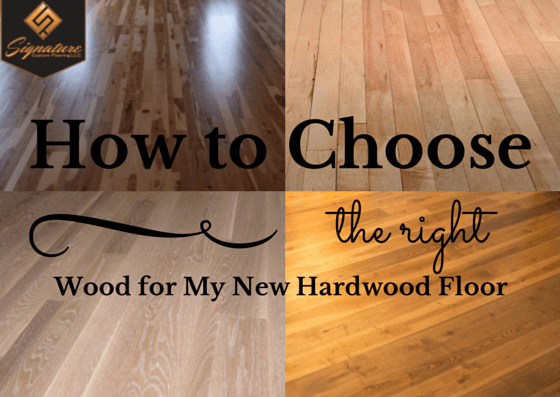How to Choose the Right Wood for My New Hardwood Floor
Posted by Aaron Schaalma
Deciding on a new hardwood floor is an exciting task but one with many options to choose from. A new hardwood floor can increase the value of your home, update the style and bring new life to your existing home.
With multiple factors influencing your ideal choice of hardwood species for your new floor, it’s important to think about everything that will affect your floor, from maintenance to installation and style to cost.
Other than color, grain and species preferences, the following will affect the type of hardwood that will work best for you:
1. Subfloor type
2. Lifestyle and living habits
3. Cost and maintenance
Here are the other factors you should think about
1. Color, décor and style
Subfloor Type
The subfloor, the floor in which your hardwood floor is installed upon, plays a role in which type of wood would work best in your space. Subfloors are often made of concrete (slab), particle board, or plywood, and each of these materials affects what is laid on top of it.
Concrete slab subfloors really only work well with engineered wood, which is a look-alike man-made material that imitates real wood. It is often made with veneers. Engineered wood floors resist moisture more than real hardwood material.
Plywood floors are more likely the most common subfloor type. Plywood subfloors allow for more options to be laid on top and it is easy to affix the new hardwood to the plywood subfloor with nails. Solid wood and engineered wood floors work well with plywood subfloors.
Particle board subfloors are not as common anymore but can be found in some older homes from the 70s. Particle board subfloors should really be replaced with plywood floors before laying a new floor down.
Lifestyle and Living Habits
Your living habits play a role in the best type of wood for your new floor too. If you have a big family with a lot of foot traffic, have pets or host parties often, a harder species of wood will last longer than a softer species. This also applies if high heels are often worn on the floor; a harder wood will resist dents from heels better than soft wood.
The Janka scale, a scale that measures the strength and hardness of wood floors, will tell you which species of woods are harder than others. While harder species of wood will have a higher defense from wear that does not mean that softer wood species should be discounted—maintenance is required by all species to keep your floor looking its best.
Cost and Maintenance
The initial cost of a hardwood floor often shocks people, but as I have said before in my previous blog post, hardwood floors are not always expensive nor hard to maintain. But these two factors will determine the species you decide on as price and maintenance do vary from species to species. Engineered hardwood is always cheaper than real hardwood, so engineered hardwood is a good option if you are on a budget.
Also, domestic hardwood floor species are typically cheaper than exotic species because of the closer proximity to where they are grown to where they are installed. But if uniqueness is what you are going for, exotic species offer that over domestic species.
Other costs you should think about include installation costs, whether you want your hardwood floor to come prefinished or unfinished, and any maintenance costs associated with having a wood floor.
The maintenance a specific wood floor requires may also influence your choice. The harder the wood species the longer the floor is expected to last, but, the finish of the floor also affects the life of it. Polyurethane finishes that are popularly used today produce a shinier coat, but light reflecting off the floor can show scratches and dents.
Another finish option is penetrating oil finish. Penetrating oil finishes are becoming more popular due to the fact that it is an all-natural, low VOC (Volatile organic compounds) finish. Like the name implies, oil finishes penetrate into the wood and also helps hide the effects of wear a little better. Penetrating finishes provide a less-shiny matte finish too. The type of finish used influences how often a floor needs to be refinished during its lifetime.
These previous factors are the factors that really affect the type of floor that would work best for you. Now for the fun part: color and style options!
Color, Style and Décor
The color that will look good in your space depends on the species (hardness) your lifestyle allows but also depends on the existing style of the space the floor is getting installed in.
When choosing the color of your floor, think about the existing color of things like your cabinets, trim and doors, and make sure those colors work well with your floor color of choice. Make sure the swatch of sample wood you are using is big enough to get the real feel of its color. I recommend at least a 2 ft. x 2 ft. swatch.
The style of the wood you choose also impacts the look your space will take on. Lighter colored species like Pine, Cypress and Hickory give off a rustic feel, while Walnut, Mahogany and Cherry will lend well to a traditional look. Also think about the décor and furnishings you have in your home and how those would blend with the style of hardwood floor you choose.
Another thing to also take into consideration is that you can have most woods stained. If you want a much more durable wood but aren’t sold on the color choices available, you could have it stained to achieve the color that would best fit the décor of your home.
When it comes time to make your final hardwood floor decision, make sure to have thought of each of these items to ensure you are getting the best, and right, hardwood floor.




